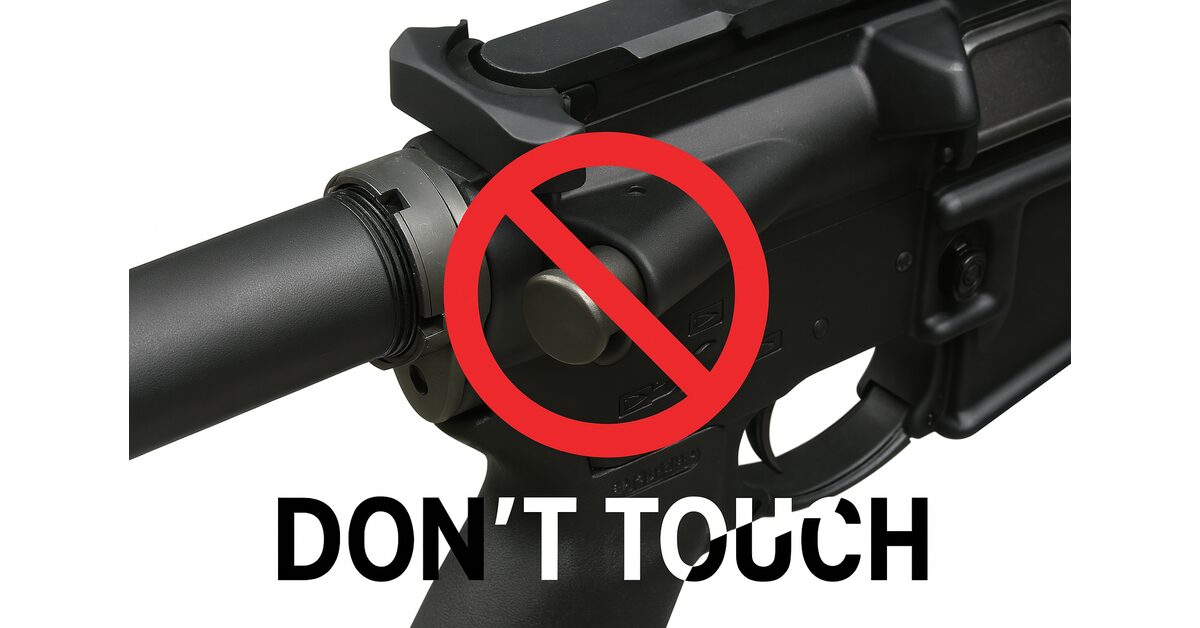What could go wrong?
The forward assist is the large button on the right side of an AR15 upper receiver. The forward assist is a battery assist device – when pressed, an internal pawl engages the serrations on the bolt carrier and pushes the bolt group deeper into the chamber forcing it into battery.
The basic premise is if the bolt fails to fully return to battery, you can push it in manually using the forward assist. So, what could possibly go wrong forcing the bolt into battery?
Let’s think this through, the bolt is returning to battery and stops, something likely has stopped it. We don’t know what that something is. But we are going to force it in because we need this particular round to fire and hope for the best?
This is sort of like forcing a stuck key deeper into a lock with a hammer, because you need the key to engage the pins in the lock.
A Lot Can Go Wrong
If your chambered is obstructed, and the bolt will not go into battery, the forward assist will not help you.
If the bolt is in battery but you get a failure to fire the forward assist will not help you.
If the round has fired but failed to extract or eject, the forward assist will not help you.
If you experience a double feed, the forward assist will not help you.
In fact, in all of these cases, you will make the situation worse. Forcing your problem deeper into the chamber is seldom the most productive choice. Bottomline: the forward assist is not a malfunction clearance tool and a lot can go wrong if you misuse it.
When Might The Forward Assist Help You
The forward assist can help you under a very narrow set of circumstances. It pushes the bolt forward; therefore, it will help you when the bolt is almost in battery but is not fully in battery. Effectively the forward assist gives the bolt a gentle nudge to finish the job.
That is it, it is a “single serve” solution, it likely will not fix the underlying issue if there is one.
But really, why didn’t go bolt go back into battery?
- If there is dirt or fouling, your forward assist does not clean your chamber.
- If it is a badly damaged and deformed cartridge, it may very well never fully chamber and the forward assist certain won’t help extract or eject the cartridge.
- If it is the wrong cartridge like a 300BLK?
Could it be a case head separation?
Worst Case Scenario: Broken Forward Assist
Yes, it is rare. But it is possible – especially when abused. See, many shooters think the forward assist is designed to be hit hard, and it often is when under-pressure, under-time or simply from panic.
The forward itself can get stuck, with the pawl applying constant pressure on the closed bolt group, completely locking up the AR15.
Here is the weak point:
- The pin retaining the forward assist assembly is vertically installed.
- The force applied to the assist is horizontal.
- Constant battering on the forward assist creates lateral shear stress on the pin.
- Over time, repeated slamming can deform or shear the pin compromising the assembly and creating a mechanical failure that is easily avoidable on a part that rarely solves problems to begin with.
This sheering doesn’t happen overnight and doesn’t happen with infrequent use, but repeated hard-use and panic slamming can absolutely damage or destroy the pin. It is an easily preventable failure.
The Better Solution: Tap-Rack-Bang
Instead of smashing the forward assist, consider the classic Tap-Rack-Bang drill. While still being given that name the technique has been modernized:
- Tap: Instead of tapping the bottom of the magazine, it is much better to grab the magazine and use a back-and-forth push/pull method to ensure your magazine is fully seated. A magazine not fully seated could explain a failure to feed.
- Rack: Pull the charging handle, this gives an opportunity for the obstruction or the problem round to be removed from the chamber. This method attempts to remove any obstruction, including if the cartridge itself is the problem.
Pro Tip: Roll the AR15 to the right so the ejection port faces the ground – it recruits gravity to work with you. - Fire: With the magazine properly seated, the chamber unobstructed, and a new fresh cartridge in the chamber, squeeze the trigger.
If you have time, opportunity and the light, you can quickly peek the chamber during the racking action. This gives you an opportunity to search for the source of the stoppage, verify the obstruction has been removed, and that the new cartridge was properly fed into the chamber.
The benefit here is you remove the cartridge associated with the problem and any other obstruction if there is one without blindly forcing anything. You can also partially diagnose the malfunction in real-time instead of guessing and hoping.
Maybe You Need A Heavier Buffer
Possibly the most effective and easiest method to improve reliability and prevent bolt return failures is to upgrade to a heavier buffer. The increased mass driving the bolt forward should help assist the bolt to return to battery automatically. The testing done by the US Marine Corp and the M16A5 program proved this conclusively. More mass is more forward motion is fewer failures to feed.
Didn’t We Need The Forward Assist In Vietnam?
No, not really.
The trouble for the M16 in Vietnam were fired casings sticking in the chamber, which has nothing to do with nor can it be resolved with the forward assist. This is why you’ve probably heard the stories of US soldiers passing around cleaning rods in the rice paddies, they were using the rods to punch out stuck casings. The forward assist, a feature not originally found in Stoner’s design and typically not found on the AR10, was added simply because the Army wanted a battery assist device and it was not requested by the Army to solve any specific problem encountered in Vietnam.
But What About Stealth Loading Or Press Checks?
I’ve heard this before and while I don’t get it, I don’t disagree, if your bolt fails to return to battery during a “stealth load” or a press check, you can hit the forward assist.
Or you can simply push on the bolt carrier directly through the ejection port. Or you can get a heavier buffer and reap all the benefits that come with it including the bolt closing during these short stroking type of exercises.
Or instead of “stealth loading” in the field, how about loading before you get there and using your safety? You could even execute your press check immediately after “loud loading” and turning on your safety.
Wouldn’t You Rather Have It And Not Need It?
Yes, I’d rather have it and not need it, but be careful not to fall into the trap of attempting to justify unnecessary gear. An “appeal to precaution” fallacy, the idea that carrying any item could be justified solely based on a very narrow use case, whilst ignoring if better options exist, its effectiveness, and its costs.
Bottomline, you don’t need the forward assist. The bolt can be forced closed without it, and malfunctions can be cleared without it.
The forward assist does have a purpose and does it well enough, and the cost is extremely low for having one. Perhaps its largest cost is tempting users into making their situation worse.
So I Should Avoid Uppers With The Forward Assist?
No, I am not suggesting this. I am saying you should understand its intended purpose and use it sparingly only for its intended purpose.
For most times and most people; diagnose the issue, don’t shove it deeper.
Final Thoughts
The forward assist is a legacy feature—iconic, but mostly unnecessary for today’s AR-15s.
It doesn’t solve major malfunctions, can tempt bad clearing habits, and adds a potential failure point. If your bolt won’t go into battery, you’re usually better off figuring out why, not blindly forcing it.
Know what your gear does—and what it doesn’t.


Leave a Reply